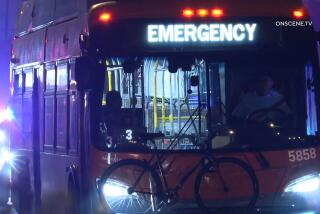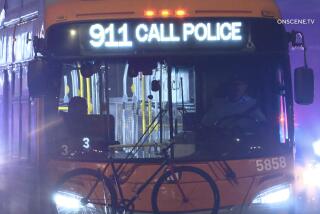Police Ride Shotgun on Mexico City Bus Route
- Share via
MEXICO CITY — More than 2 million commuters returned here from a peaceful Easter weekend to a bus system under siege Monday, as the government deployed SWAT-team helicopters and more than 1,500 police to drive and ride shotgun on the city’s longest, busiest bus route.
This massive deployment, or “security operation” as officials termed it, was the latest development in a scandal surrounding the city’s bankrupt Route 100 bus company, which has thrown public transit into chaos in the largest city on the globe.
The snarl also has become a key battleground between the government and opposition labor since city officials declared the bus company bankrupt, seized it and jailed a top union boss for alleged embezzlement a week ago.
Officials said the police presence Monday, the first day the government tried to restore service to the key line, was meant to deter attacks by Route 100’s 13,700 union workers, all of whom were fired after the government takeover.
Amid continuing threats by union leaders to disrupt transit operations, police appeared to have deterred violence on the bus line.
But signs of the chaos--and the economic crisis that helped spawn it--filled this sprawling capital all day. Commuters waited for up to an hour for buses that were overflowing with passengers when they arrived. On other company routes, there was no service at all.
Officials conceded that service is unlikely to improve soon. They said the “emergency” was so intense that it appeared to have contributed to last week’s suicide by the city’s transport secretary.
At a news conference called to justify what looked to many analysts like a police action against one of the nation’s largest independent unions--so powerful that it has prevented the city government from offering concessions for more bus routes--Mexico City Mayor Oscar Espinoza acknowledged that normalcy will not be restored until early May.
“The transportation system in Mexico City does not satisfy anyone,” he declared, promising a sweeping modernization of the anarchic system, in which buses clog most major arteries throughout the day and commuters must take several different forms of transportation between home and work.
He blamed much of the disaster on Route 100 itself, a private, government-financed transit company that he called “a terrible use of government subsidies” and “the biggest obstacle” to modernizing the public transportation network.
Backed by the powerful labor union, he said, Route 100 and its directors blocked city attempts to grant concessions to other operators. He asserted that the company was awash with corruption and inefficiency.
More to Read
Sign up for Essential California
The most important California stories and recommendations in your inbox every morning.
You may occasionally receive promotional content from the Los Angeles Times.










